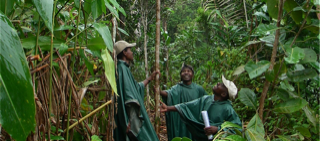Overview
In collaboration with local communities, the project aims to assess the state of degradation and start restoration activities in three national parks that are part of the UNESCO World Heritage Site ‘Rainforests of the Atsinanana”, one of the most important and representative habitats of Madagascar humid forests with exceptional levels of biodiversity. These rainforests are currently placed in the World Heritage in Danger list, and projected restoration activities respond to the correctives measures requested by the World Heritage Center in its decision to list the site as ‘in danger’. A preliminary study will be conducted to map priority areas of natural habitat loss through a baseline assessment of degradation. Local communities will be trained to participate in defined restoration interventions and pilot natural regeneration interventions will be carried out through actions recommended by the preliminary study in 3 national parks of the World Heritage Site. The project will report on the success of pilot activities, with conclusions on the benefits to local communities and recommendations for the future planning of restoration activities in the World Heritage site and beyond.
Quick Facts
Project Location:
Atsinanana, Madagascar, -18.8131481, 48.879997199999934
Geographic Region:
Africa
Country or Territory:
Madagascar
Biome:
Tropical Forest
Ecosystem:
Tropical Forest - Moist Broadleaf
Area being restored:
123 ha
Project Lead:
Madagascar National Parks
Organization Type:
Governmental Body
Project Partners:
CBD / FERI
Madagascar Ministry of the Environment, Ecology and Forests
Location
Project Stage:
Implementation
Start Date:
2018-06
End Date:
2019-06
Primary Causes of Degradation
DeforestationDefining the Reference Ecosystem
The reference ecosystem is primarily based on contemporary reference sites or existing analogues of the pre-degradation ecosystem.Project Goals
1. Plan and pilot restoration activities in 3 parks of the World Heritage Site “Rainforests of the Atsinanana” and the wider eastern rainforest Ecoregion. These restoration activities respond to the corrective measures requested by the World Heritage Centre, in its decision to list the site as ‘in danger’;
2. Contribute to the implementation of national objectives related to ecosystem restoration: National Biodiversity Strategy and Action Plan 2015-2025, Madagascar Nationally Determined Contributions, National Strategy on Forest Landscape Restoration, etc.;
3. Ensure the sustainability of the Project by empowering local communities and demonstrating how they can benefit from restoration interventions; and
4. Improve the efficiency of restoration by identifying interventions that maximize impact of and minimize costs in different contexts
Monitoring
The project does not have a monitoring plan.
Stakeholders
The local communities are the privileged partners of MNP for all its activities. 1092 people, some fifty of whom are women, participate in conservation activities, including restoration, at the level of the project area. They are structured into Local Park Committees) since 2013 in the framework of co-management established for the network of protected areas managed by MNP. The governance model used by MNP in the project’s 3 National Parks complies with the governance principles of the Madagascar System of Protected Areas, as defined in the law recasting the Code of Protected Areas. Therefore the neighboring communities will be the main partners in the realization of this project.
How this project eliminated existing threats to the ecosystem:
Carry out pilot natural regeneration interventions through exclosure of the sites intended for this purpose and other actions, as recommended by the preliminary study
How this project reinstated structural diversity (e.g. strata, faunal food webs, spatial habitat diversity):
Conduct a study to identify priority areas of natural habitat to be restored and the most appropriate restoration interventions
How this project reestablished external exchanges with the surrounding landscape (e.g. migration, gene flow, hydrology):
Training of local communities for their participation in defined restoration interventions
Ecological Outcomes Achieved
Socio-Economic & Community Outcomes Achieved
Long-Term Management
In terms of monitoring, at the end of the project, the restored plots will be integrated into the ecological monitoring system and will be monitored annually by MNP. Each year, a report on the state of conservation of the property is sent to UNSECO / CPM, which includes monitoring the restoration of degraded areas through cuts, clearing and illegal mining including the 3 project sites.
Sources and Amounts of Funding
FERI: $150,000
Other Resources
https://www.feri-biodiversity.org/atsinanana
Primary Contact
Name:
Liliane Parany
Affiliation:
Madagascar National Parks http://www.parcs-madagascar.com/
City:
Antananarivo


